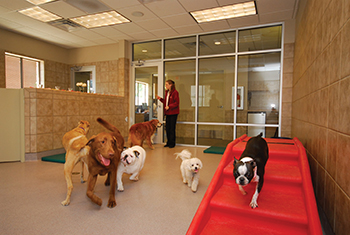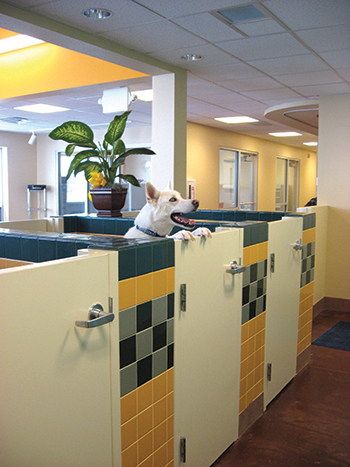
We’ve Come a Long Way, (Fur) Baby!
By Bryan King
When it comes to the quality and quantity of boarding facilities, we’ve come a long way in recent years! What began as a very simple and utilitarian kennel industry has grown to a mature marketplace of boarding and daycare facilities that put the health and welfare of our pets at the forefront.
There are two significant influences that have driven these changes within the industry. Science has led to a better understanding of what animals need environmentally to be safe and healthy. Additionally, the anthropomorphism of our four-legged friends and changing human demographics have led many to seek out greater comforts for the pets they see as family members. Even the language of the industry reflects this trend, with various pet “hotel,” “spa,” and “resort” monikers for what in years past was considered part of the generic kennel industry. The demand for luxury boarding has become as important to the industry as the more science-backed necessities of quality boarding.

In 1977, a concerned group of kennel operators founded the American Boarding Kennels Association (ABKA). Around the same time, science began to develop criteria that changed the way people thought about the care of boarded animals. There was a growing awareness that well-ventilated, easier-to-clean facilities would positively contribute to animal health and would also create a better work environment for staff. As a result, state-of-the-art animal care facilities began including well-designed ventilation systems and quality finish materials that could stand up to continuous cleaning.
A good resource for understanding what science has to say about animal care is The Association of Shelter Veterinarians’ publication, “Guidelines for Standards of Care in Animal Shelters,” issued in 2010. While these guidelines were written by veterinarians for the shelter industry, they are meant to be applicable to any facility providing for the care and housing of companion animals.
Cleaning Business – Start with the Basics
Everyone who has owned or operated a boarding facility knows that the business requires a working knowledge that ranges from veterinary medicine and animal behavior to retail, hospitality, and more. Developing the perfect blend of these services for a specific market is what sets each and every boarding facility apart from its competition.
Regardless of your specific business plan, the one thing that should be clear to anyone who has ever run an animal boarding facility is this: there is a lot of cleaning involved. The operational plan for your business should take into account cleaning protocols and required staffing, and then the building must be designed to support that operational plan.
Some boarding facilities operate in virtually hose-free environments. This approach can save money by eliminating expensive plumbing but may dictate a higher level of staffing to ensure that pets are walked outdoors in relief areas and that staff are available for quick spot cleaning whenever accidents occur. Traditional operations tend to be hose heavy with lots of drains, wash downs, and even high-pressure washers. When considering cleaning methods, it is important to remember that the method you choose could limit your design choices. Even ceramic tile environments that can stand up to regular hosing may not withstand daily attacks with a high-pressure washer.

Low walls for dog suites can really open up well-staffed boarding kennels.
Noise, odor, and disease control should be at the top of the priority list for anyone operating a boarding or daycare facility. A well-designed facility that is easy to clean and maintain is also likely to be odor and disease free. The catch-22 is that any surface that will absorb sound can also absorb water and cannot be effectively cleaned and sanitized. For this reason, most animal housing environments include hard, cleanable surfaces from the floor to four to six feet up the wall and then rely on the upper walls and ceilings to have sound-absorbing surface treatments. Due to these limited opportunities for noise absorption, it is a good idea to use the best and highest-performing acoustical materials practical.
Keeping It Fresh
Good cleaning practice is the first line of defense against odors. Proper cleaning protocols and durable building materials serve as the foundation for an odor-free facility. Beyond that, ventilation needs to be provided. That helps keep the air fresh and minimizes opportunities for disease transfer between boarded animals.
The best designed mechanical systems operate with higher air exchange rates than are typically required by building code and higher than what would otherwise be needed to provide the necessary heating and cooling. It is best to exhaust all of the air from animal areas rather than recirculate it, but a great deal of energy gets used in the process of exhausting the air. In many climates, it can make sense to exhaust air through energy recovery units. These systems use the exhaust air to “pre-temper” the outside air and are able to capture some of the energy that was already used for heating or cooling.
Although some designers recommend heavy filtration of the air to help control odor in lieu of 100% exhaust, our experience is that this approach is less desirable. The additional filters can create a maintenance burden and, when improperly maintained, significantly compromise the performance of the systems. The energy benefit from filtering and recirculating the air is also offset by the additional fan power needed to force the air through all of the filtration.
Design Consistency
Good design should carry throughout the building, from the front door to the staff entrance. First impressions matter, so putting your best foot forward in the lobby and other public areas of your facility is important for marketing your services to your clientele. Putting in this same effort and attention to detail in the service and support areas of your facility will allow your business to run more smoothly. In particular, kitchen facilities and equipment (stainless steel sinks, tubs, etc.), a commercial laundry, and appropriate accommodations for grooming should be budgeted into the business plan and included in the design.
When designing a boarding or daycare facility, embrace your vision and use design features that appeal to you or that can set you apart from your competition. When executing the design, don’t forget to start with the basics to ensure that you end up with a facility that is easy to maintain and considers the health and welfare of the animals first!
References
- Guidelines for Standards for Care in Animal Shelters, The Association of Shelter Veterinarians 2010 http://sheltervet.org/wp-content/uploads/2012/08/Shelter-Standards-Oct2011-wForward.pdf
- NFPA 150 - “Standard on Fire and Life Safety in Animal Housing Facilities” http://www.nfpa.org/aboutthecodes/AboutTheCodes.asp?DocNum=150
- Planning and Building an Animal Shelter – An Operational Guide, American Humane Association http://www.americanhumane.org/assets/pdfs/animals/operational-guides/op-guide-planninganimalshelter.pdf
Bryan M. King, AIA, is a principal at Animal Arts, an architectural firm that has exclusively designed animal care facilities since 1979. Bryan is a licensed architect with a degree from the University of Illinois. He has spent 23 years working in architecture, the last 11 with Animal Arts. Animal Arts has designed animal shelters, veterinary hospitals and boarding facilities in 40 states, Canada, Australia, Japan, and Singapore. Among their boarding facility design credits are the Olde Towne Pet Resorts in Springfield and Sterling, Virginia. Animal Arts offers full architectural design services from programming through construction administration. animalarts.biz.


